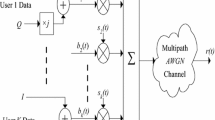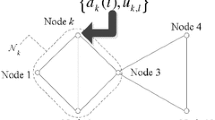Abstract
The application of the minimum-mean-square-error (MMSE) multiuser detection technique to the problem of suppressing the digital narrowband interference (NBI) from spread-spectrum signals is considered. The MMSE multiuser detector can be implemented using a blind adaptive method, which is ideally suited for use in the NBI suppression framework. The optimal linear filter for the recovery of the spread-spectrum signal is derived, and its performance is analyzed in terms of probability of error and signal-to-interference ratio (SIR). It is shown that the performance of this optimal filter is very close to the situation when there is no narrowband interference present, even at the presense of very strong interference. This application requires the treatment of a single narrowband digital signal as a group of related, virtual spread-spectrum signals with very simple spreading codes. This model gives a special structure to the matrices appearing in the optimization problem implied by the MMSE criterion, and this structure is exploited herein to develop and analyze a practical adaptive algorithm. The major contribution of this paper beyond the previous work in the field of NBI suppression is the development of this adaptive algorithm that can exploit the advantages of multiuser detection in suppressing narrowband digital interference from spread-spectrum networks.
Similar content being viewed by others
References
S. Haykin, Adaptive Filter Theory, second edition. Prentice-Hall, 1994.
M. Honig, U. Madhow and S. VerdÚ, “Blind multiuser detection”, IEEE Trans. Inform. Theory, Vol. 41, No.4, pp. 944–960, July 1995.
U. Madhowand M. Honig, “MMSE Interference Suppression forDirect-Sequence Spread-Spectrum CDMA”, IEEE Trans. Commu., Vol. 42, pp. 3178–3188, 1994.
E. Masry, “Closed-form analytical results for the rejection of narrow-band interference in PN spread-spectrum systems - Part I: Linear prediction filters”, IEEE Trans. Commun., Vol. COM-32, pp. 888–896, 1984.
E.Masry, “Closed-form analytical results for the rejection of narrow-band interference in PN spread-spectrum systems - Part II: Linear interpolation filters”, IEEE Trans. Commun., Vol. COM-33, pp. 10–19, 1985.
L.B. Milstein, “Interference rejection techniques in spread spectrum communications”, Proc. IEEE, Vol. 76, No.6, pp. 657–671, 1988.
L.B. Milstein, et al., “On the feasibility of a CDMA overlay for personal communications networks”, IEEE Journal on Selected Areas in Communications, Vol. 10, pp. 655–668, 1992.
U. Mitra and H.V. Poor, “Adaptive receiver algorithms for near-far resistant CDMA”, IEEE Trans. Commun., Vol. 43, No.2/3/4, Part III, pp. 1713–1724, 1995.
H.V. Poor and L.A. Rusch, “Narrowband interference suppression in spread spectrum CDMA”, IEEE Personal Communications Magazine, Vol. 1, No.3, pp. 14–27, 1994.
H.V. Poor and S. VerdÚ, “On the bit-error probability of MMSE multiuser detection”, IEEE Trans. Inform. Theory, Vol. 43, No.3, May 1997, to appear.
H.V. Poor and X. Wang, Code-aided interference suppression in DS/CDMA spread-spectrum communications: Interference suppression capability. IEEE Trans. Commun., 1997, to appear.
H.V. Poor and X. Wang, Code-aided interference suppression in DS/CDMA spread-spectrum communications: Blind adaptive implementations. IEEE Trans. Commun., 1997, to appear.
L.A. Rusch and H.V. Poor, Narrowband interference suppression in CDMA spread spectrum communications. IEEE Trans. Commun., Vol. 42, No.2, pp. 1969–1979, 1994.
L.A. Rusch and H.V. Poor, “Multiuser detection techniques for narrowband interference suppression in spread spectrum communications”, IEEE Trans. Commun., Vol. 4, No.2/3/4, Part III, pp. 1725–1737, 1995.
S. VerdÚ, “Multiuser Detection”. In: Advances in Statistical Signal Processing - Vol. 2: Signal Detection, H.V. Poor and J.B. Thomas, eds. (JAI Press: Greenwich, CT, 1993), pp. 369–410.
R. Vijayan and H.V. Poor, Nonlinear techniques for interference suppression in spread spectrum systems. IEEE Trans. Commun., Vol. 38, No.7, pp. 1060–1065, 1990.
Author information
Authors and Affiliations
Rights and permissions
About this article
Cite this article
Vincent Poor, H., Wang, X. Blind Adaptive Suppression of Narrowband Digital Interferers from Spread Spectrum Signals. Wireless Personal Communications 6, 69–96 (1998). https://doi.org/10.1023/A:1008884302081
Issue Date:
DOI: https://doi.org/10.1023/A:1008884302081




